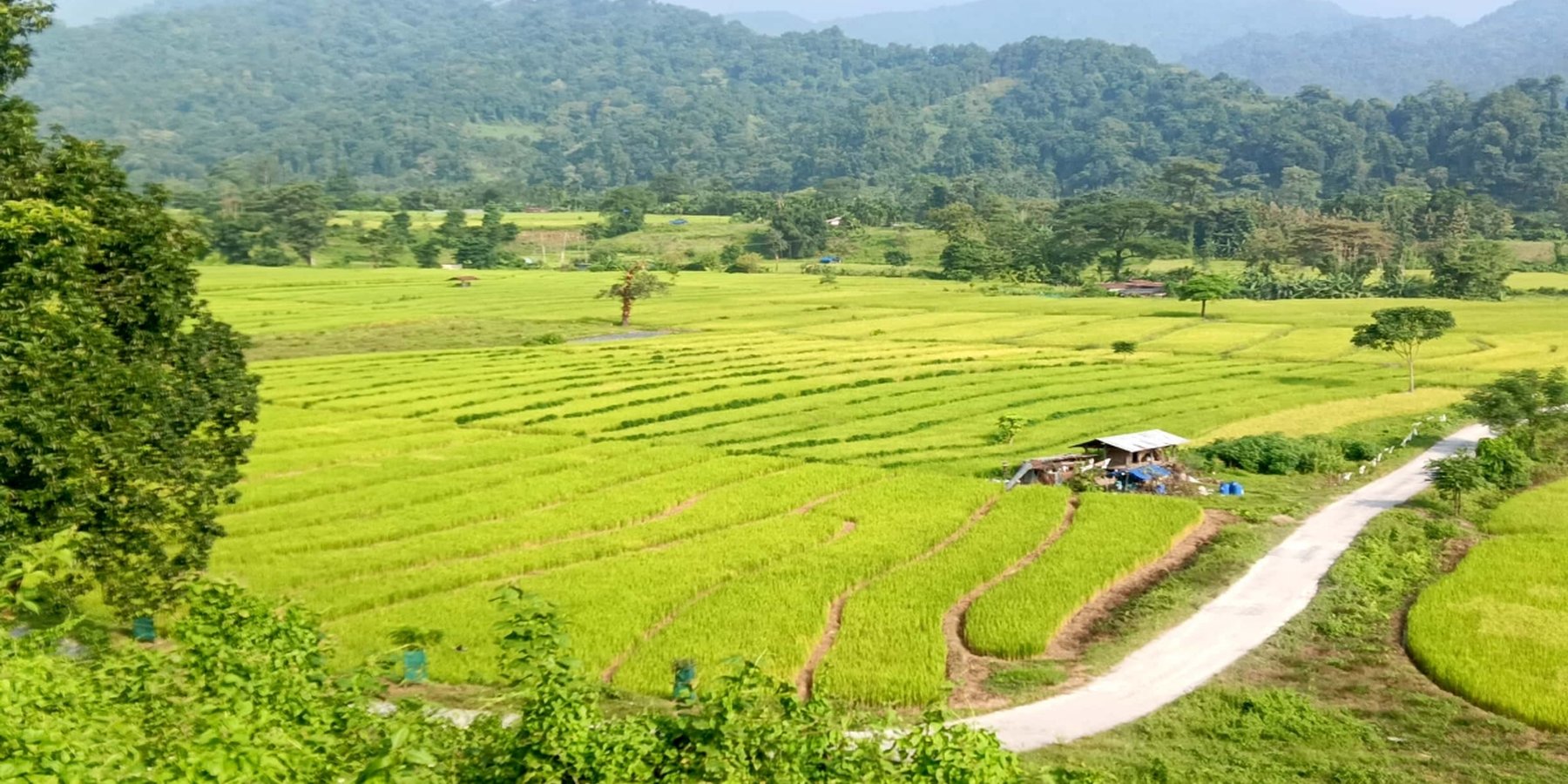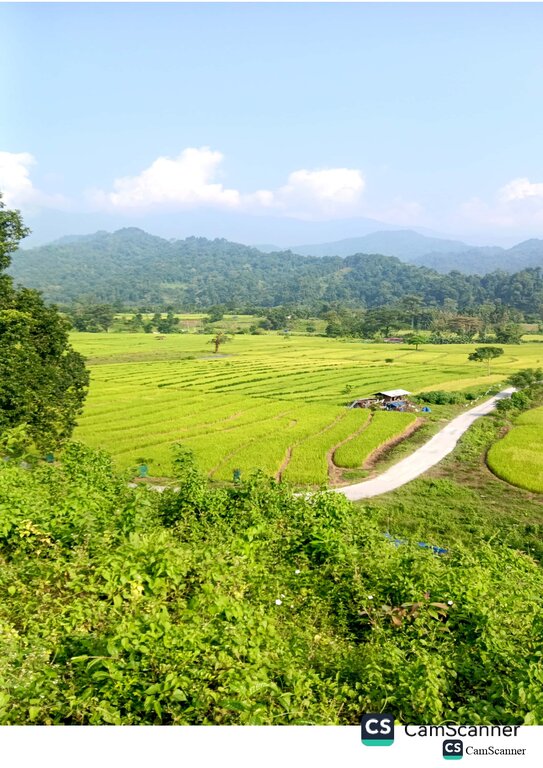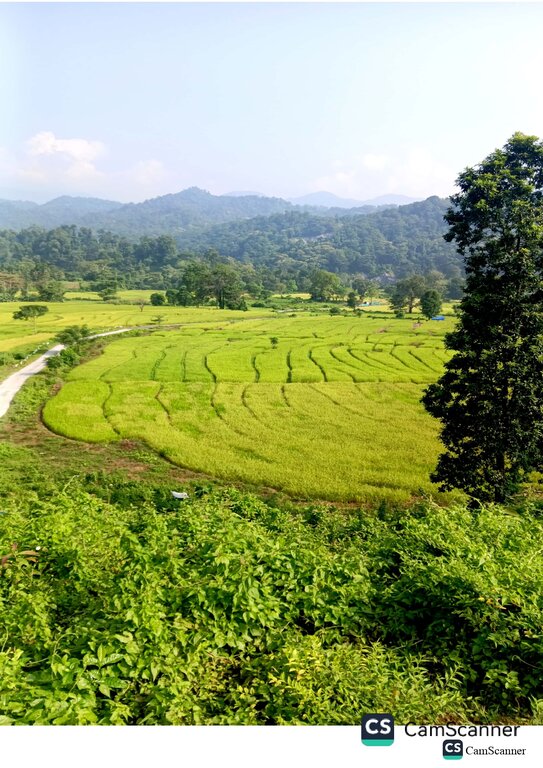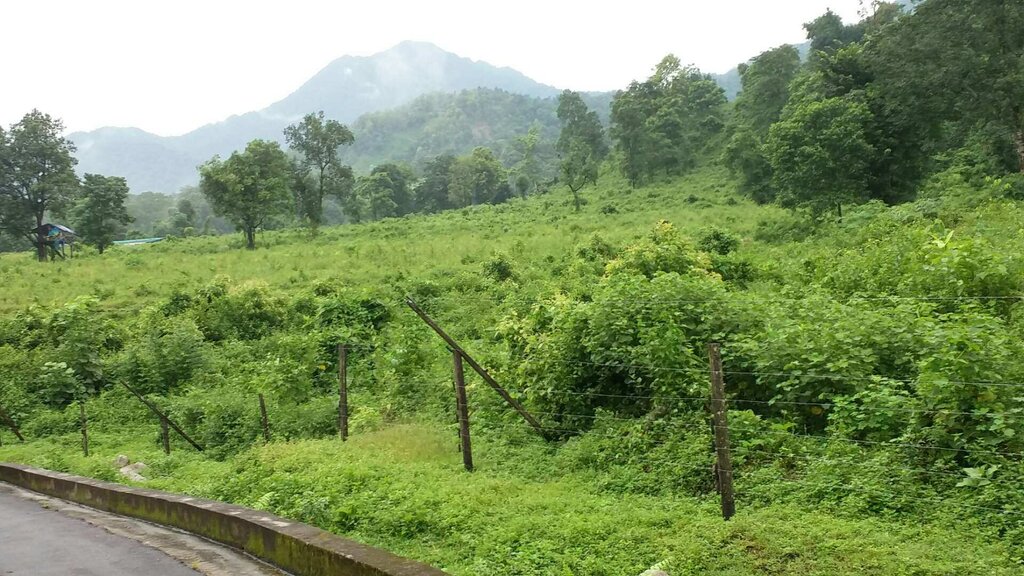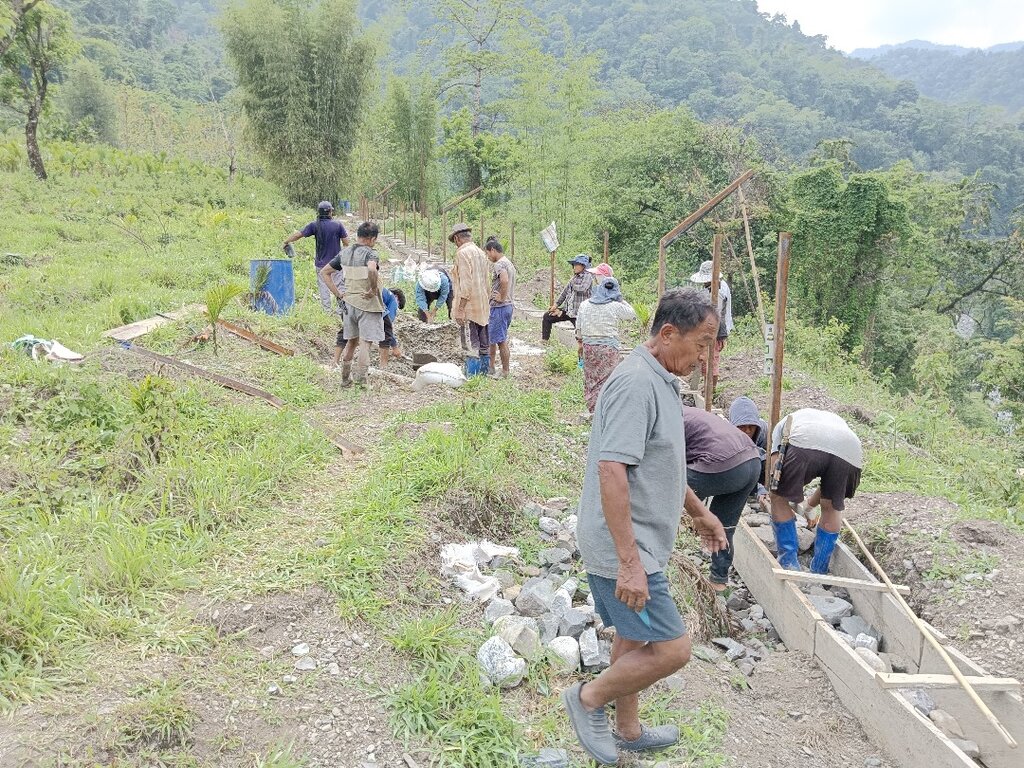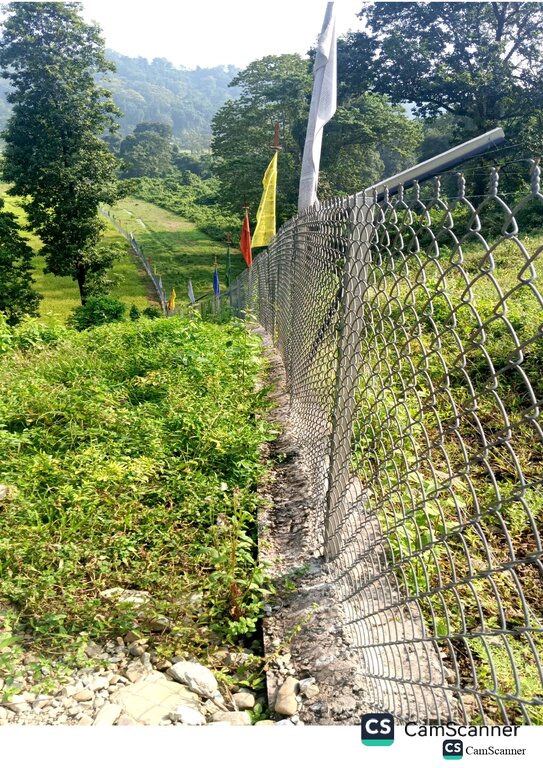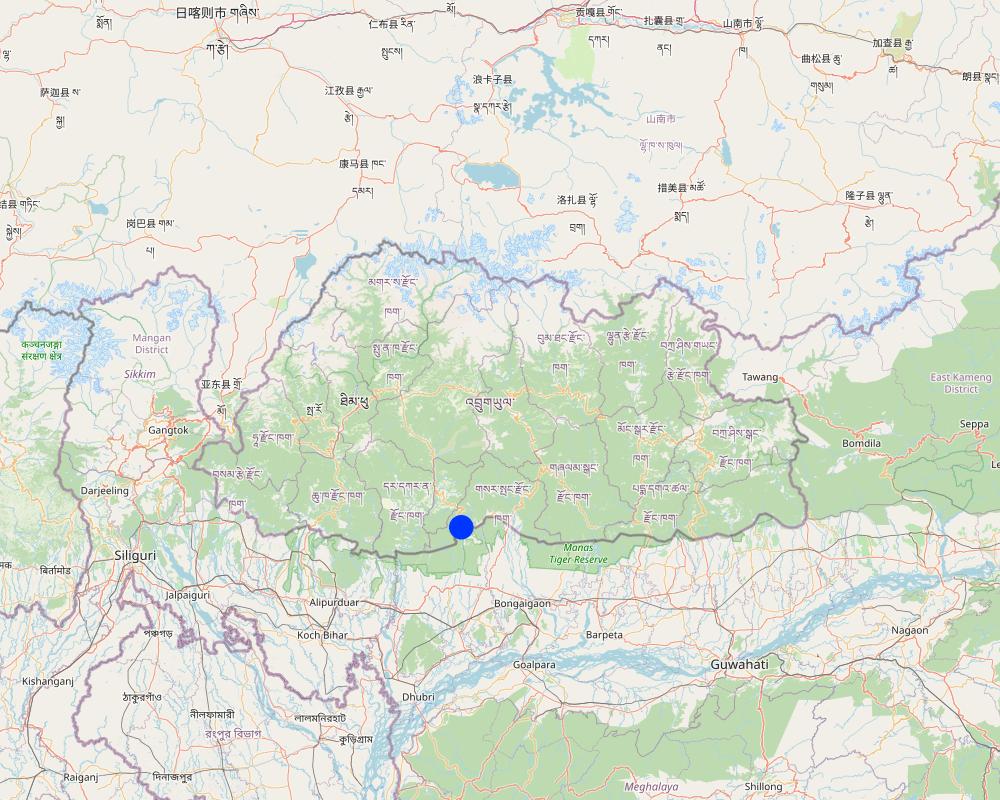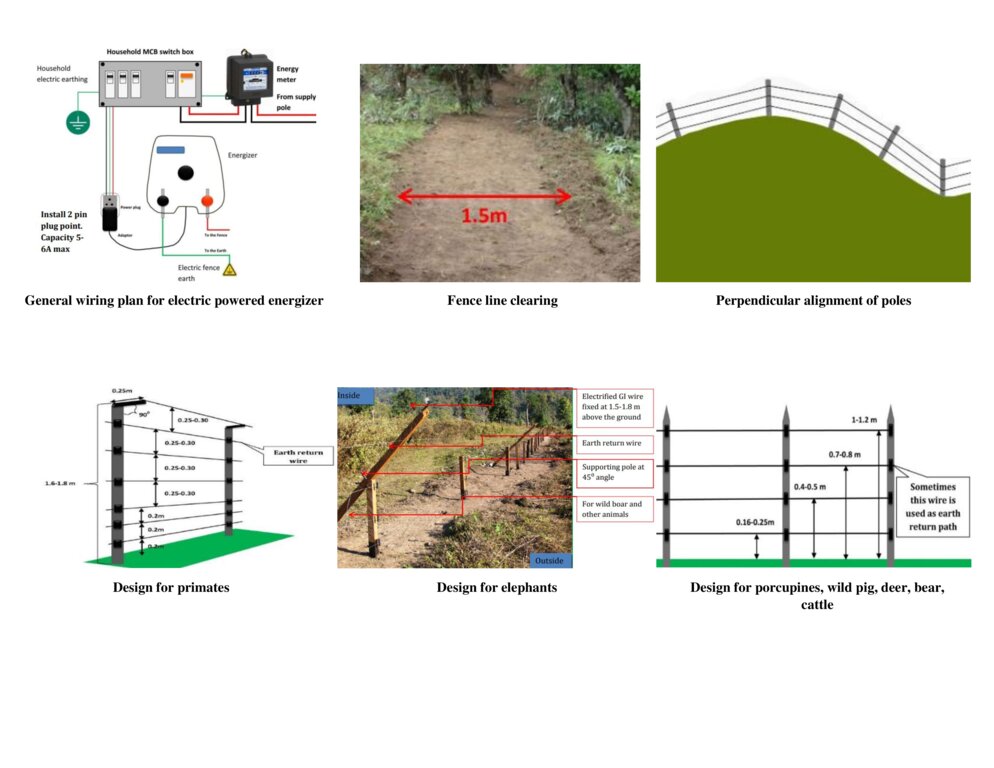Securing Food Through Electric Fencing [Bhutan]
- Creation:
- Update:
- Compiler: Nima Dolma Tamang
- Editor: Chenga Tshering
- Reviewers: William Critchley, Rima Mekdaschi Studer
gLog-May-Raow
technologies_6830 - Bhutan
View sections
Expand all Collapse all1. General information
1.2 Contact details of resource persons and institutions involved in the assessment and documentation of the Technology
Key resource person(s)
land user:
Tashi Tshering
Bhutan
Gewog Agriculture Extension Officer:
Wangdi Thinley
Gewog Agriculture office, Senggye Gewog, Sarpang Dzongkhag
Bhutan
Name of project which facilitated the documentation/ evaluation of the Technology (if relevant)
Strengthening national-level institutional and professional capacities of country Parties towards enhanced UNCCD monitoring and reporting – GEF 7 EA Umbrella II (GEF 7 UNCCD Enabling Activities_Umbrella II)Name of the institution(s) which facilitated the documentation/ evaluation of the Technology (if relevant)
National Soil Services Centre, Department of Agriculture, Ministry of Agriculture & Livestock (NSSC) - Bhutan1.3 Conditions regarding the use of data documented through WOCAT
The compiler and key resource person(s) accept the conditions regarding the use of data documented through WOCAT:
Yes
1.4 Declaration on sustainability of the described Technology
Is the Technology described here problematic with regard to land degradation, so that it cannot be declared a sustainable land management technology?
No
Comments:
Based on the responses provided by the interviewee (Group Chairman), it appears that electric fences may not directly contribute to mitigating land degradation. However, they can be considered as part of a technological approach, particularly in terms of adaptation, given their effectiveness in land restoration, fallow land reversion, ensuring food security, and ultimately enhancing livelihoods.
2. Description of the SLM Technology
2.1 Short description of the Technology
Definition of the Technology:
The Electric Fencing System in Bhutan serves as a non-lethal approach to safeguarding crops from wild animals, aligning with the principles of Gross National Happiness (GNH). GNH emphasizes values such as compassion, non-killing, and harmonious coexistence with nature and its elements.
2.2 Detailed description of the Technology
Description:
The Electric Fencing System in Bhutan serves as a non-lethal approach to safeguarding crops from wild animals, aligning with the principles of Gross National Happiness (GNH). GNH emphasizes values such as compassion, non-killing, and harmonious coexistence with nature.
The National Plant Protection Centre (NPPC), Department of Agriculture (DoA), Ministry of Agriculture and Livestock (MoAL) has been facilitating the application and installation of electric fence systems nationwide. This is achieved through the provision of comprehensive guidelines to help the public comprehend the fundamental components and installation procedures.
In essence, the electric fence system consists of three major parts: Energizers, Insulators, and Earth return. The energizer is responsible for generating high-voltage pulse electricity (ranging from 9-12 KV), which is then delivered along the fence wires. The majority of energizers are directly connected to the electricity line, while in some isolated cases, solar panels and batteries are used as alternative power sources. Insulators are typically crafted from a non-conductive material and serve as a barrier between the electrified wire and the wooden post. In the Bhutanese market, these insulators are not readily available, thus as an alternative, high-density polyethylene (HDPE) pipe has been found to be effective and cheap. The electric fence earth return serves as an essential pathway in the electric circuit, collecting high voltage and current from the earth and returning it to the energizer.
The loss of crops to wild animals leads to increased production costs in Bhutan (time spent in crop guarding) and the expansion of fallow lands. Farmers often resort to illegal and fatal methods of electric fencing, tapping electricity directly from the main line. To address these issues, the implementation of electric fencing, utilizing imported IEC-certified energizers and locally fabricated fencing materials, has proven to be successful. This electric fencing system, introduced after five years of pre-testing across the country, covers various locations targeting different problem species of animals. Not only is this technology effective in controlling wild pests, but it also enjoys high social acceptance among Bhutanese farmers due to its cost-effectiveness and being non-lethal to wild pests.
A recent study on the impact of electric fencing on food security focused on the Laptsakha community in Senggye Gewog, Sarpang Dzongkhag. They faced threats to food security from elephants, boar and stray cattle from neighboring communities in India. Crop production in Laptsakha was negligible before the introduction of electric fencing: resettled households contemplated returning, fertile lands were left fallow, and incomes shrank. The turning point came in 2013 with the introduction of electric fencing. This intervention successfully mitigated wildlife attacks on crops, ensuring food security and contributing to a harmonious ecosystem and improved livelihoods for the people of Laptsakha.
The electric fence, covering a distance of 7 km, protects a total of 60 households in all, safeguarding about 60 (24 ha) acres of vulnerable lands. Electric fences have various benefits including:
•Harmonious Approach: they do not cause harm to animals beyond a repellent shock.
•Economical and Easy to Build: they are cost-effective and relatively easy to construct.
•Learning and Deterrence: animals quickly learn to respect electric fences.
•Durability: they have an extended service life.
•Versatility: they offer a variety of designs and can control a wide range of wild animals.
The installation of an electric fence involves a participatory approach and several key steps:
•Location and Length: determine the location and approximate length of the electric fence either by manual measurement, or remote technologies for larger expanses.
•Material Estimation: estimate the required materials per kilometre based on the identified area, including wooden poles, HDPE pipe, and GI wire.
•Additional Materials: Consider other essential materials like energizers, solar panels, charge controllers, and batteries, depending on the specific requirements.
•Cost Estimation: Calculate the cost of installation, which varies regionally. For example, to instal one kilometre of an electric fence is estimated at about Nu. 7,450 (USD 95) excluding labour costs and cost of wooden poles which is sourced locally.
The implementation of electric fencing in the community has brought significant advantages, particularly in securing food. Prior to this intervention, the community faced severe challenges in harvesting crops, with approximately 70% of fertile lands being left fallow due to constant human-wildlife conflicts. Crop guarding became routine & risky.
With the introduction of electric fences, the community's agricultural landscape has undergone a positive transformation. Crop diversification has been enhanced, encompassing maize, ginger, paddy, mandarin fruit trees and areca nut. The frequency of wild elephant attacks has significantly decreased, leading to a notable increase in crop production. This has resulted in secured food sources and improved livelihoods. Additionally, the community has successfully revived previously fallow lands.
While the electric fencing has proven effective, there are challenges faced by the land users, notably the frequent damage to energizers, primarily attributed to thunderstorms. This has resulted in higher maintenance costs. In one specific instance, the community had to mobilize approximately Nu. 145,000 (USD 1800) independently to replace damaged energizers and other materials, supplementing the continued support from the government.
2.3 Photos of the Technology
2.5 Country/ region/ locations where the Technology has been applied and which are covered by this assessment
Country:
Bhutan
Region/ State/ Province:
Sarpang Dzongkhag
Further specification of location:
Laptsakha Village, Senggye Gewog
Specify the spread of the Technology:
- applied at specific points/ concentrated on a small area
Is/are the technology site(s) located in a permanently protected area?
Yes
If yes, specify:
The Laptsakha community (electric fencing site) falls under Phibsoo Wildlife Sanctuary.
Comments:
The Phibsoo Wildlife Sanctuary, situated in western Sarpang Dzongkhag and south-eastern Dagana Dzongkhag along the border with West Bengal, is the second-smallest national park in Bhutan, covering an area of 268.93 square kilometers. This sanctuary is linked to Jigme Singye Wangchuck National Park and Royal Manas National Park through a biological corridor that crosses a national highway. The elevations within the sanctuary range from 200 meters to 1,600 meters.
Map
×2.6 Date of implementation
Indicate year of implementation:
2013
2.7 Introduction of the Technology
Specify how the Technology was introduced:
- through projects/ external interventions
Comments (type of project, etc.):
The electric fencing program in the community was facilitated by the former Renewable Natural Resources and Development Centre (RNR-DC) - Yusipang, now known as the National Center for Organic Agriculture- Yusipang. Additionally, the expertise of the electric fence specialist from ARDC - Wengkhar, Mongar (Eastern Bhutan) was involved in the implementation of the program.
3. Classification of the SLM Technology
3.1 Main purpose(s) of the Technology
- improve production
- reduce, prevent, restore land degradation
- preserve/ improve biodiversity
- create beneficial economic impact
- create beneficial social impact
3.2 Current land use type(s) where the Technology is applied
Land use mixed within the same land unit:
Yes
Specify mixed land use (crops/ grazing/ trees):
- Agroforestry

Cropland
- Annual cropping
- Perennial (non-woody) cropping
Annual cropping - Specify crops:
- cereals - maize
- cereals - millet
- cereals - rice (wetland)
Perennial (non-woody) cropping - Specify crops:
- areca
- pineapple
- Banana, cardamom
Number of growing seasons per year:
- 2
Specify:
Maize in summer is followed by chilli in winter.
Is intercropping practiced?
Yes
If yes, specify which crops are intercropped:
The people of Laptsakha cultivate paddy (wetland) and soybean simultaneously. The soybean is grown along the terrace bunds, especially as a border crop.
Is crop rotation practiced?
Yes
If yes, specify:
The maize harvest is followed by chilli cultivation

Forest/ woodlands
- (Semi-)natural forests/ woodlands
(Semi-)natural forests/ woodlands: Specify management type:
- Selective felling
- Non-wood forest use
Type of (semi-)natural forest:
- subtropical humid forest natural vegetation
- Mixed broad leaves
Are the trees specified above deciduous or evergreen?
- mixed deciduous/ evergreen
Products and services:
- Timber
- Fuelwood
- Grazing/ browsing
3.3 Has land use changed due to the implementation of the Technology?
Has land use changed due to the implementation of the Technology?
- No (Continue with question 3.4)
Comments:
The introduction of electric fencing in the community has not led to a change in land use patterns. However, there has been a notable transformation in land cover over the years. Prior to the implementation of electric fencing, approximately 70% of the currently cultivated lands (comprising 325 acres, including 168 acres of dry land and 157 acres of wetland) were left fallow due to the threat of wildlife (human-wildlife conflict). The introduction of electric fencing has played a crucial role in revitalizing these fertile fallow lands, bringing them back into cultivation.
3.4 Water supply
Water supply for the land on which the Technology is applied:
- mixed rainfed-irrigated
Comments:
The community is well-equipped with two full-time irrigation sources: Mahajan Irrigation and Ghantay Irrigation canals. However, the reliance on irrigation is reduced when there is sufficient rainfall. Therefore, they describe the irrigation system as a mixed approach, combining both irrigation sources and rainwater.
3.5 SLM group to which the Technology belongs
- natural and semi-natural forest management
- integrated pest and disease management (incl. organic agriculture)
- wetland protection/ management
3.6 SLM measures comprising the Technology

structural measures
- S6: Walls, barriers, palisades, fences
- S10: Energy saving measures
Comments:
The electric fence can be a structural measure that ensures energy savings due to its versatility (solar and electric-power options). It can be also considered as one of the structural measures ensuring a harmonious environment.
3.7 Main types of land degradation addressed by the Technology

biological degradation
- Bc: reduction of vegetation cover
- Bh: loss of habitats
- Bq: quantity/ biomass decline
Comments:
The electric fencing ensures harmonious environment for wild life. Their lives are prevented from fatal threats being attempted by farmers in controlling wild pests. Hence, they are dedicated with the safe habitats, which ultimately results in enhanced bio-diversity.
3.8 Prevention, reduction, or restoration of land degradation
Specify the goal of the Technology with regard to land degradation:
- prevent land degradation
- reduce land degradation
Comments:
The electric fence plays an important role in preventing and reducing land degradation. The lands encompassed within the electric fence are well managed and put to good use (higher ground coverage with year-round cultivation, proper nutrient management, and others). Caring for these productive lands encircled by electric fencing thereby either prevents or reduces land degradation ultimately.
4. Technical specifications, implementation activities, inputs, and costs
4.1 Technical drawing of the Technology
Technical specifications (related to technical drawing):
Insulators are prepared using HDPE pipes (32 mm or 25 mm in diameter, with a pressure capacity of 10 kg/cm2). These pipes are cut into 10-11 cm lengths, with holes drilled at the center, and then secured with two 3-inch nails at both ends, maintaining a 1.50 cm distance from edges. The fencing process involves clearing a fence line with a width of at least 1.5 m. Wooden poles (10 to 18 cm in diameter) are erected perpendicular to the ground, spaced 2.5 to 3 m apart in flat lands and 2 m or less in sloped areas.
For fences designed to control smaller species like rabbits and porcupines, the first wire is positioned about 0.14 to 0.16 m from the ground. Fences for larger animals such as wild boars, deer, and bears require 3 to 4 strands of wires positioned at 0.25, 0.4 to 0.5, 0.7 to 0.8, and 1 to 1.2 m from the ground. In the case of elephants, one or two strands of wire should be positioned at 1.5 to 1.8 m from the ground, and supporting poles should be erected at 45-degree angles from the entrance side of the field.
The height of the fence is adapted based on the target animals, such as monkeys. Typically, the 7th strand is supported on a 25 cm HDPE pipe fixed on top of the wooden pole at a 90-degree angle to the entrance side of the field. This design prevents monkeys from climbing the wooden posts and jumping into the field.
Author:
National Plant Protection Centre (NPPC), DoA, MoAL
Date:
08/07/2023
4.2 General information regarding the calculation of inputs and costs
Specify how costs and inputs were calculated:
- per Technology unit
Specify unit:
kilometre
other/ national currency (specify):
Ngultrum (Nu.)
If relevant, indicate exchange rate from USD to local currency (e.g. 1 USD = 79.9 Brazilian Real): 1 USD =:
80.0
Indicate average wage cost of hired labour per day:
250
4.3 Establishment activities
| Activity | Timing (season) | |
|---|---|---|
| 1. | Area identification through Google Map by ARDC-Yusipang | 2013, Winter |
| 2. | Cleaning of vegetation along the identified fence line (10 m width) | 2013, Winter (after crop harvest) |
| 3. | Ground clearing and levelling (2 m width) | 2013, Winter (after crop harvest) |
| 4. | Gathering of fencing poles | 2013, Winter (after crop harvest) |
| 5. | Procurement and facilitation of materials (energizers, solar panels, nails, GI wire, insulation pipes) | 2013, Winter (after crop harvest) |
| 6. | Execution of fencing activities | 2013, Winter (after crop harvest) |
Comments:
The actual electric fencing works in Laptsakha, measuring a distance of seven kilometres was completed in less than a month. Better community cooperation was a major reason behind this success, as per the Group's chairman.
4.4 Costs and inputs needed for establishment
| Specify input | Unit | Quantity | Costs per Unit | Total costs per input | % of costs borne by land users | |
|---|---|---|---|---|---|---|
| Labour | Man | Person-days | 1600.0 | 250.0 | 400000.0 | 100.0 |
| Equipment | Energizer | No. | 6.0 | 9500.0 | 57000.0 | |
| Equipment | GI wire (SWG 16) | Kg | 356.0 | 95.0 | 33820.0 | |
| Equipment | Nail (3 inch) | Kg | 106.0 | 82.0 | 8692.0 | |
| Equipment | Solar Panel (20 watts) | No. | 6.0 | 7000.0 | 42000.0 | |
| Equipment | Charge controller | No. | 6.0 | 1800.0 | 10800.0 | |
| Equipment | Acidic Battery | No. | 6.0 | 2800.0 | 16800.0 | |
| Equipment | Lubricants (Gear oil) | Litre | 6.0 | 254.0 | 1524.0 | |
| Equipment | Insulators (HDPE pipe [32 mm]) | Metre | 781.0 | 48.0 | 37488.0 | |
| Construction material | Wooden poles | No. | 1400.0 | 100.0 | ||
| Other | Other accessories | NA | 1.0 | 1000.0 | 1000.0 | |
| Total costs for establishment of the Technology | 609124.0 | |||||
| Total costs for establishment of the Technology in USD | 7614.05 | |||||
If land user bore less than 100% of costs, indicate who covered the remaining costs:
National Centre for Organic Agriculture, Yusipang
Comments:
The labour contribution was from Laptsakha and Nichula villages as the electric fencing benefitted both villages. Therefore, a higher number of land users are involved in the construction of the technology.
The total cost for the establishment of the technology is USD 7614.05 for 7 km (USD 1087.7 for 1 km). This includes labour cost which is borne by the land users.
4.5 Maintenance/ recurrent activities
| Activity | Timing/ frequency | |
|---|---|---|
| 1. | Replacement of energizers during breakdowns | As and when breakdown occurs |
| 2. | Fence line clearing | Monthly |
Comments:
Between 2013 and 2019, approximately 20 energizer sets had to be replaced due to thunderstorm damage. To address this issue, the community transitioned to using solar-powered energizers instead of electricity, proving to be a more effective solution. Double batteries were employed to ensure consistent current flow during cloudy days. As part of the routine maintenance, the clearing of the fence line became a monthly task, with each household assigned an area of approximately 116 meters to manage.
4.6 Costs and inputs needed for maintenance/ recurrent activities (per year)
| Specify input | Unit | Quantity | Costs per Unit | Total costs per input | % of costs borne by land users | |
|---|---|---|---|---|---|---|
| Labour | Labor | Person-days | 59.0 | 700.0 | 41300.0 | 100.0 |
| Total costs for maintenance of the Technology | 41300.0 | |||||
| Total costs for maintenance of the Technology in USD | 516.25 | |||||
If you are unable to break down the costs in the table above, give an estimation of the total costs of maintaining the Technology:
145000.0
Comments:
The beneficiaries covered the cost of acquiring the damaged energizers through monthly contributions of Nu. 200 per household and other penalty revenues. The total costs for maintenance of the technology is USD 516.25 for 7 km ( USD 73.75 for 1 km).
4.7 Most important factors affecting the costs
Describe the most determinate factors affecting the costs:
The primary factor incurring the cost, according to the beneficiaries, was the energizer set, which necessitates frequent replacement.
5. Natural and human environment
5.1 Climate
Annual rainfall
- < 250 mm
- 251-500 mm
- 501-750 mm
- 751-1,000 mm
- 1,001-1,500 mm
- 1,501-2,000 mm
- 2,001-3,000 mm
- 3,001-4,000 mm
- > 4,000 mm
Specifications/ comments on rainfall:
The most recent climate data 2017, published by NCHM was used.
Indicate the name of the reference meteorological station considered:
Station: Bhur, Type: Class A, Station ID: 23310046
Agro-climatic zone
- humid
The area falls under the humid subtropical zone from the six Agro-ecological zones in Bhutan.
5.2 Topography
Slopes on average:
- flat (0-2%)
- gentle (3-5%)
- moderate (6-10%)
- rolling (11-15%)
- hilly (16-30%)
- steep (31-60%)
- very steep (>60%)
Landforms:
- plateau/plains
- ridges
- mountain slopes
- hill slopes
- footslopes
- valley floors
Altitudinal zone:
- 0-100 m a.s.l.
- 101-500 m a.s.l.
- 501-1,000 m a.s.l.
- 1,001-1,500 m a.s.l.
- 1,501-2,000 m a.s.l.
- 2,001-2,500 m a.s.l.
- 2,501-3,000 m a.s.l.
- 3,001-4,000 m a.s.l.
- > 4,000 m a.s.l.
Indicate if the Technology is specifically applied in:
- not relevant
Comments and further specifications on topography:
The gentle plain dominates the area with a slope ranging from 2 to 5 per cent.
5.3 Soils
Soil depth on average:
- very shallow (0-20 cm)
- shallow (21-50 cm)
- moderately deep (51-80 cm)
- deep (81-120 cm)
- very deep (> 120 cm)
Soil texture (topsoil):
- coarse/ light (sandy)
Soil texture (> 20 cm below surface):
- coarse/ light (sandy)
Topsoil organic matter:
- high (>3%)
If available, attach full soil description or specify the available information, e.g. soil type, soil PH/ acidity, Cation Exchange Capacity, nitrogen, salinity etc.
Moisture content 3.31%, organic matter 7.16%, Organic carbon 4.16%, pH 6.81, electrical conductivity 261.97 µs/cm, nitrogen 0.21%, phosphorus 0.34 ppm, Potassium 201.07 mg/100ml, texture sand clay loam.
The soil analysis was conducted at the Science Laboratory of College of Natural Resources, Royal University of Bhutan, Lobesa, Punakha.
5.4 Water availability and quality
Availability of surface water:
good
Water quality (untreated):
good drinking water
Water quality refers to:
surface water
Is water salinity a problem?
No
Is flooding of the area occurring?
No
5.5 Biodiversity
Species diversity:
- high
Habitat diversity:
- high
Comments and further specifications on biodiversity:
The rich periphery environment, higher vegetation coverage, and evident agroforestry indicate high species and habitat diversity.
5.6 Characteristics of land users applying the Technology
Sedentary or nomadic:
- Sedentary
Market orientation of production system:
- mixed (subsistence/ commercial)
Off-farm income:
- less than 10% of all income
Relative level of wealth:
- average
Individuals or groups:
- groups/ community
Level of mechanization:
- mechanized/ motorized
Gender:
- women
- men
Age of land users:
- youth
- middle-aged
5.7 Average area of land used by land users applying the Technology
- < 0.5 ha
- 0.5-1 ha
- 1-2 ha
- 2-5 ha
- 5-15 ha
- 15-50 ha
- 50-100 ha
- 100-500 ha
- 500-1,000 ha
- 1,000-10,000 ha
- > 10,000 ha
Is this considered small-, medium- or large-scale (referring to local context)?
- small-scale
- large-scale
Comments:
The average land holding area of native households accounts for about 2 acres, falling under small-scale referring to the local context.
However, the land holding area of re-settled households in the community is 5 acres, falling under medium-scale referring to the local context.
The average household land holding in Bhutan is 3.4 acres. Therefore, the land users owning more than 3.4 acres are categorized as large-scale and less than 3.4 acres are categorized as small-scale.
5.8 Land ownership, land use rights, and water use rights
- Family land ownership
Land use rights:
- individual
Water use rights:
- communal (organized)
Are land use rights based on a traditional legal system?
Yes
Specify:
The land use rights in Bhutan is traditional legal system guided by formal land act and land rules and regulations.
5.9 Access to services and infrastructure
health:
- poor
- moderate
- good
education:
- poor
- moderate
- good
technical assistance:
- poor
- moderate
- good
employment (e.g. off-farm):
- poor
- moderate
- good
markets:
- poor
- moderate
- good
energy:
- poor
- moderate
- good
roads and transport:
- poor
- moderate
- good
drinking water and sanitation:
- poor
- moderate
- good
financial services:
- poor
- moderate
- good
Comments:
The community is striving for the upgradation of the present primary school to high school.
6. Impacts and concluding statements
6.1 On-site impacts the Technology has shown
Socio-economic impacts
Production
crop production
Quantity before SLM:
219 kg paddy from one acre wetland
Quantity after SLM:
1090 kg of paddy from one acre wetland
Comments/ specify:
There is a significant increase in the crop production. The production before electric fencing was almost zero due to wild elephant attacks. However, the issue is resolved due to the electric fence intervention.
crop quality
Comments/ specify:
The beneficiaries believe that the quality of the crop has improved based on visual observation and sensory evaluations (taste). This could be due to reduced trampling of the crop by wild animals.
risk of production failure
Quantity before SLM:
20% of paddy harvest from one acre wetland
Quantity after SLM:
100% of paddy harvest from one acre wetland
Comments/ specify:
The human-wildlife conflict was the major factor causing production failure in the past. The risk of production failure is reduced by 100% as the land is secured from wild animal intrusion.
product diversity
Quantity before SLM:
Ginger cultivation was not possible
Quantity after SLM:
Now the land users cultivates ginger
Comments/ specify:
Ginger cultivation before electric fencing was not possible due to wild elephants straggling in the fields. Currently, the land users grow ginger leading to product diversity.
production area
Comments/ specify:
A major portion of the arable land was not cultivated in the past due to wild animal depredation, now the land users engage in various agricultural activities in that land.
land management
Comments/ specify:
The electric fencing technology has made the land suitable for agricultural activities. Motivating the land users to manage the land better by sourcing irrigation and reducing land degradation. However, the land users are not able to manage landslides in the area.
Income and costs
expenses on agricultural inputs
Comments/ specify:
The expenditure of money and time to guard the field is significantly reduced as the crop destruction by wild animals was eradicated with electric fence intervention.
farm income
Comments/ specify:
The technology enabled the land users to engage in commercial farming. Further, the time required to guard the crop can be dedicated to other productive farm activities.
diversity of income sources
Comments/ specify:
The land users are engaged in diverse crop cultivation leading to diversified income sources.
workload
Comments/ specify:
The workload involved in guarding the crop is significantly reduced.
Socio-cultural impacts
food security/ self-sufficiency
Comments/ specify:
The land users in the Laptsakha community are self-sufficient in cereals and most vegetables. Before the technology introduction, the land users were not involved in cultivation of crops and approximately 70% of the land was left fallow. The land users were dependent on imported food products. However, the technology has enabled farming activities including cereals and vegetable production making the land users self-sufficient. The surplus produce is sold in the market fetching good income with which the land users can purchase quality food products that are not grown in the field increasing the food security of the community.
health situation
Comments/ specify:
The land users believe that the health situation of the community has improved. The possible reason could be due to the consumption of diverse and organic food products available from their field.
cultural opportunities
Comments/ specify:
The electric fencing has added aesthetic value to the community, where community has been recognized as one of the successful electric fencing pilot sites. Moreover, external visitors are attracted to witness the success of the community.
Also, the community bond has been strengthened, through a approach like labour sharing instituted during the implementation of the technology.
recreational opportunities
Comments/ specify:
The time required to guard the field previously can be utilized in recreational activities.
SLM/ land degradation knowledge
Comments/ specify:
The electric fence and land degradation do not exhibit a direct relationship. However, the technology encourages the land user to value their land and implement management practices ultimately improving the knowledge and skills SLM.
conflict mitigation
Comments/ specify:
There is a significant improvement in human-wildlife conflict management.
situation of socially and economically disadvantaged groups
Comments/ specify:
Disadvantaged land users having inadequate human resources benefit from the technology leading to improved situation of the household.
Ecological impacts
Biodiversity: vegetation, animals
Vegetation cover
Comments/ specify:
The land users' involvement in the destruction of the forest cover surrounding the farm is reduced. The practice was aimed at chasing wild animals. However, with the reduction of this practice, there is higher vegetation cover.
biomass/ above ground C
Comments/ specify:
There is enhanced vegetation cover in the surrounding forest and on the crop land leading to increased biomass.
habitat diversity
Comments/ specify:
The destruction of natural habitats has been reduced due to least forest-poaching .
6.2 Off-site impacts the Technology has shown
Biological diversity conservation outside farmland
Comments/ specify:
The area protected by the electric fencing covers farmland and forest areas. Therefore, the flora diversity is improved as it is not lost to wildlife depredation.
6.3 Exposure and sensitivity of the Technology to gradual climate change and climate-related extremes/ disasters (as perceived by land users)
Gradual climate change
Gradual climate change
| Season | increase or decrease | How does the Technology cope with it? | |
|---|---|---|---|
| annual temperature | increase | not known |
Climate-related extremes (disasters)
Meteorological disasters
| How does the Technology cope with it? | |
|---|---|
| local rainstorm | very well |
| local thunderstorm | not well |
| local windstorm | very well |
Hydrological disasters
| How does the Technology cope with it? | |
|---|---|
| flash flood | not well at all |
| landslide | not well at all |
Comments:
As per the interviewee, the annual rainfall has remained constant over the past decade. However, there has been a noticeable shift in the rainfall pattern, characterized by erratic rainfall. In previous years, the rainfall followed a seasonal pattern, which is no longer consistent in recent times.
6.4 Cost-benefit analysis
How do the benefits compare with the establishment costs (from land users’ perspective)?
Short-term returns:
very positive
Long-term returns:
very positive
How do the benefits compare with the maintenance/ recurrent costs (from land users' perspective)?
Short-term returns:
very positive
Long-term returns:
very positive
6.5 Adoption of the Technology
- > 50%
If available, quantify (no. of households and/ or area covered):
The 7 km electric fencing program has benefitted 60 households.
Of all those who have adopted the Technology, how many did so spontaneously, i.e. without receiving any material incentives/ payments?
- 0-10%
Comments:
The initial establishment was done through external support by covering the whole community catchment area. One-time maintenance involving the cost of Nu. 145,000/- was initiated by the community by mobilizing their fund.
6.6 Adaptation
Has the Technology been modified recently to adapt to changing conditions?
Yes
other (specify):
Due to target animal species
Specify adaptation of the Technology (design, material/ species, etc.):
The existing electric fence, operational up to now, underwent significant modifications, incorporating a chain-link fence valued at 1.10 million between February and May 2023. This alteration is intended to deter active wildlife pests, specifically monkeys and elephants.
6.7 Strengths/ advantages/ opportunities of the Technology
| Strengths/ advantages/ opportunities in the land user’s view |
|---|
| Electric fencing aligns with the convictions of the land users, avoiding harm to wildlife as a means of protecting the land from wild animals. |
| Scaring wild animals with a mild electric shock, the technology deters them from approaching due to the fear of the electric shock from the fence. |
| Creating a favorable environment for agricultural activities, the technology encourages land users to participate in farming, resulting in increased production and household income. |
| Strengths/ advantages/ opportunities in the compiler’s or other key resource person’s view |
|---|
| Reduced risk of loss of life: Wild animals, particularly elephants, pose a threat to the lives of land users, with some reported fatalities. The technology can help mitigate or prevent such incidents. |
| The replication of this technology can eliminate fatal attempts made by land users in various parts of the country to control wild pests. |
6.8 Weaknesses/ disadvantages/ risks of the Technology and ways of overcoming them
| Weaknesses/ disadvantages/ risks in the land user’s view | How can they be overcome? |
|---|---|
| Continuous break down of energizers has incurred high maintenance costs | Solar-powered fencing has been the best alternative as implemented by the community. |
| Clearing of the land under the fence is labourious and time consuming. | Timely monitoring of the clearing activity should be done. |
| Weaknesses/ disadvantages/ risks in the compiler’s or other key resource person’s view | How can they be overcome? |
|---|---|
| The GI wire experiences swift rusting. | Timely greasing and utilizing superior quality GI wire. |
7. References and links
7.1 Methods/ sources of information
- field visits, field surveys
The key informants were the agriculture Extension Agent, and the Chairman of the electric fencing group.
- interviews with land users
Chairman represented the group, as per the indication from Agriculture extension agent.
- compilation from reports and other existing documentation
The manuals and guidelines developed by the National Plant Protection Centre (NPPC), Bhutan was referred for general background information.
When were the data compiled (in the field)?
07/07/2023
7.3 Links to relevant online information
Title/ description:
Technical Reference Manual for installation and maintenance of Electric Fence, National Plant Protection Centre (NPPC), n.d.
URL:
https://www.nppc.gov.bt/electric-fencing-manual/
Title/ description:
Implementation Guidelines for Electric Fencing System, National Plant Protection Centre (NPPC), 2015
URL:
https://www.nppc.gov.bt/electric-fencing-manual/
Title/ description:
EF accessories, National Plant Protection Centre (NPPC), 2015
URL:
https://www.nppc.gov.bt/ef-accessories/
7.4 General comments
The questionnaire is not easy to apply for such technology in terms of sections 2.5 and 4.2. Under section 2.5 “specify the spread of the technology” the options are not applicable for this technology implemented in 7 km length. Under section 4.2. it is difficult to specify units for the cost calculation. The cost for overall technology implementation can be added. However, the cost specified in km is not uniform. For example, the cost for 1 km could be USD 95 but for 2 km it will be less than USD 190 as there is no need for two energizers and other accessories.
Links and modules
Expand all Collapse allLinks
No links
Modules
No modules


